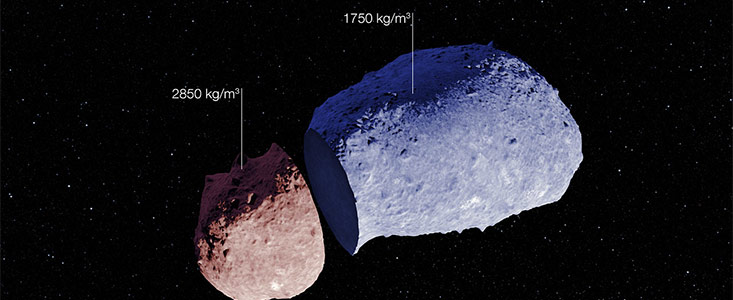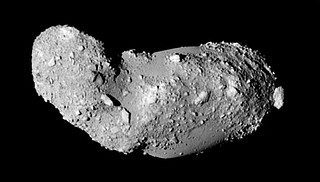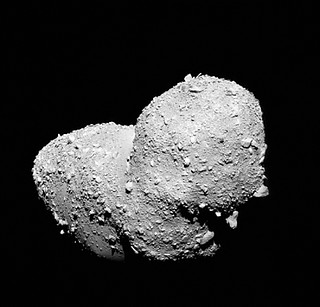| Online: | |
| Visits: | |
| Stories: |

| Story Views | |
| Now: | |
| Last Hour: | |
| Last 24 Hours: | |
| Total: | |
The Anatomy Of An Asteroid
ESO’s New Technology Telescope (NTT) has been used to find the first evidence that asteroids can have a highly varied internal structure. By making exquisitely precise measurements astronomers have found that different parts of the asteroid Itokawa have different densities. As well as revealing secrets about the asteroid’s formation, finding out what lies below the surface of asteroids may also shed light on what happens when bodies collide in the Solar System, and provide clues about how planets form.

Credit: ESO

Credit: JAXA
This very detailed view shows the strange peanut-shaped asteroid Itokawa. By making exquisitely precise timing measurements using ESO’s New Technology Telescope a team of astronomers has found that different parts of this asteroid have different densities. As well as revealing secrets about the asteroid’s formation, finding out what lies below the surface of asteroids may also shed light on what happens when bodies collide in the Solar System, and provide clues about how planets form. This picture comes from the Japanese spacecraft Hayabusa during its close approach in 2005.

Credit: JAXA
Credit: JAXA, ESO/L. Calçada/M. Kornmesser/Nick Risinger (skysurvey.org).
The spin of an asteroid and other small bodies in space can be affected by sunlight. This phenomenon, known as the Yarkovsky-O’Keefe-Radzievskii-Paddack (YORP) effect, occurs when absorbed light from the Sun is re-emitted from the surface of the object in the form of heat. When the shape of the asteroid is very irregular the heat is not radiated evenly and this creates a tiny, but continuous, torque on the body and changes its spin rate [3], [4].
Lowry’s team measured that the YORP effect was slowly accelerating the rate at which Itokawa spins. The change in rotation period is tiny — a mere 0.045 seconds per year. But this was very different from what was expected and can only be explained if the two parts of the asteroid’s peanut shape have different densities.
This is the first time that astronomers have found evidence for the highly varied internal structure of asteroids. Up until now, the properties of asteroid interiors could only be inferred using rough overall density measurements. This rare glimpse into the diverse innards of Itokawa has led to much speculation regarding its formation. One possibility is that it formed from the two components of a double asteroid after they bumped together and merged.
Credit: JAXA, ESO/L. Calçada/M. Kornmesser/Nick Risinger (skysurvey.org).
Lowry added, “Finding that asteroids don’t have homogeneous interiors has far-reaching implications, particularly for models of binary asteroid formation. It could also help with work on reducing the danger of asteroid collisions with Earth, or with plans for future trips to these rocky bodies.”
This new ability to probe the interior of an asteroid is a significant step forward, and may help to unlock many secrets of these mysterious objects.
[1] As well as the NTT, brightness measurements from the following telescopes were also used in this work: Palomar Observatory 60-inch Telescope (California, USA), Table Mountain Observatory (California, USA), Steward Observatory 60-inch Telescope (Arizona, USA), Steward Observatory 90-inch Bok Telescope (Arizona, USA), 2-metre Liverpool Telescope (La Palma, Spain), 2.5-metre Isaac Newton Telescope (La Palma, Spain) and the Palomar Observatory 5-metre Hale Telescope (California, USA).
[2] The density of the interior was found to vary from 1.75 to 2.85 grammes per cubic centimetre. The two densities refer to Itokawa’s two distinct parts.
[3] As a simple and rough analogy for the YORP effect, if one were to shine an intense enough light beam on a propeller it would slowly start spinning due to a similar effect.
[4] Lowry and colleagues were the first to observe the effect in action on a small asteroid known as 2000 PH5 (now known as 54509 YORP, see eso0711). ESO facilities also played a crucial role in this earlier study.
More information
This research was presented in a paper “The Internal Structure of Asteroid (25143) Itokawa as Revealed by Detection of YORP Spin-up”, by Lowry et al., to appear in the journal Astronomy & Astrophysics.
Contacts and sources:
Richard Hook
ESO
Source: http://www.ineffableisland.com/2014/02/the-anatomy-of-asteroid.html



